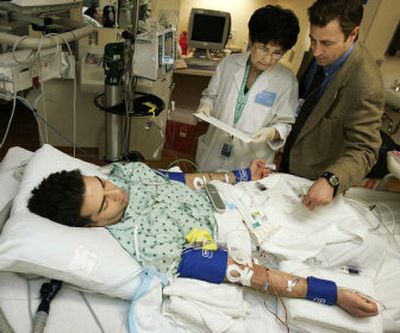Hot dog preservative shows promise as drug

WASHINGTON – Could the salt that preserves hot dogs also preserve your health?
Scientists at the National Institutes of Health think so. They’ve begun infusing sodium nitrite into volunteers in hopes that it could prove a cheap but potent treatment for sickle cell anemia, heart attacks, brain aneurysms, even an illness that suffocates babies.
Those ailments have something in common: They hinge on problems with low oxygen, problems the government’s research suggests nitrite can ease.
Beyond repairing the reputation of this often maligned meat preservative, the work promises to rewrite scientific dogma about how blood flows, and how the body tries to protect itself when that flow is blocked. Indeed, nitrite seems to guard tissues – in the heart, the lungs, the brain – against cellular death when they become starved of oxygen.
It doesn’t mean artery-clogging hot dogs are healthy.
But the NIH researchers have filed for new patents on this old, overlooked chemical and are hunting a major pharmaceutical company to help develop it as a therapy – even as doctors await the enrollment of sick patients into research studies in coming months. The scientists are so convinced of nitrite’s promise that lead researcher Dr. Mark T. Gladwin says the government will pursue drug development on its own if necessary.
“We are turning organs into hot dogs,” Gladwin jokes. Then he turns serious: “We think we stumbled into an innate protection mechanism.”
If it works, “this drug would be pennies to dollars per day,” says Dr. Christian Hunter of California’s Loma Linda University. By January, Hunter hopes to begin studies of nitrite treatment for babies with an often fatal disease called pulmonary hypertension. “It’s so easy to use.”
Gladwin and an NIH cardiologist, Dr. Richard Cannon III, discovered nitrite’s effect by accident while studying a related compound, nitric oxide, long known to improve blood flow by dilating blood vessels, but difficult to use as a drug.
Gladwin and Cannon injected sodium nitrite into healthy volunteers. Tiny doses almost tripled blood flow. Moreover, when people exercised, nitrite levels plummeted in the muscles being worked – the body was using it.
The researchers were stunned. For 100 years, scientists thought nitrite had little medical relevance.
High doses are an antidote for cyanide poisoning, but they’re also toxic. In 1944, 11 New Yorkers literally turned blue, their blood struggling for oxygen, after they accidentally ate the meat preservative instead of table salt.
The low levels that naturally occur in the human body were thought to be inert, unimportant. Not anymore.
The work done so far is “sufficiently encouraging to warrant a full-court press,” says Dr. Franklin Bunn, a Harvard Medical School professor who has reviewed much of the research.
When oxygen levels drop, the body’s natural stores of nitrite convert to nitric oxide, in turn dilating vessels so that more blood – and more oxygen – gets through.
That’s Step 1. Then there’s tissue preservation.
Consider: Even after doctors clear a blocked artery to end a heart attack, heart muscle continues to die for a while.
Nitrite interrupts that chain reaction, caused when harmful proteins spewed by dying cells in turn take out their neighbors, says David Lefer of Louisiana State University Health Sciences Center in Shreveport.
But the heart’s nitrite stores are depleted quickly.
“When you have a heart attack, you use it all up in the first few minutes keeping the organ alive,” Lefer says. “You need to add some more.”
So Lefer bred mice with low nitrite levels, clipped off the rodents’ main heart artery for 30 minutes, and infused nitrite before opening the artery back up.
The salt cut by 67 percent the amount of heart muscle that died.
Gladwin says it worked as well in dogs, whose hearts are similar to people’s. He hopes a study in people suffering heart attacks could begin next year.
The first human patients to test nitrite have sickle cell disease; another piece of the nitrite puzzle is its connection to hemoglobin, the oxygen-carrying protein that makes blood red.
Doctors have long thought the bouts of crippling pain suffered by sickle cell patients resulted when their abnormally shaped red blood cells clumped together to block blood flow.
But these red cells also dump large amounts of hemogloblin into blood plasma, where it gobbles up nitric oxide, Gladwin found. That constricts blood vessels, causing more pain as sickle-shaped blood cells push through.
At NIH’s hospital in Bethesda, Md., Gladwin has infused nitrite into six sickle-cell patients. This first-stage study is designed to test safety, not nitrite’s effect on pain, but it is dilating participants’ blood vessels, he says.
It’s a surprising revival for a substance once suspected of spurring cancer. But sodium nitrite also is found in leafy green vegetables, Gladwin likes to note – although no one knows if eating it would bring any of the possible pharmaceutical benefit.
“The idea it’s bad for you has not played out,” he says. “The fact it was linked to hot dogs gave it a bad name.”